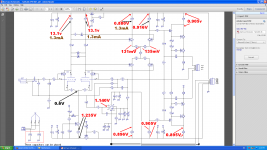Could someone please explain pics #3 and #4? Where do these spikes at 300 Hz and 8 kHz in #3, and those between 10 and 20 kHz in #4 result from? Thank you!
Best regards!
Best regards!
This is the Indermodulation distortion test.Could someone please explain pics #3 and #4? Where do these spikes at 300 Hz and 8 kHz in #3, and those between 10 and 20 kHz in #4 result from? Thank you!
Best regards!
We drive the amplifier with a two tone signal,one tone is a 250Hz signal and the other is 8Khz signal.Anything between two basic tones are <<generated>>into the amplifier and that is we call indermodulation distortion.
The same for other two frecuencyes 13Khz and 14Khz.
I hope that is a simple explanation.
December 2016. My measurements of the early prototype - the same schematic, but the layout is a TH version of Tubsumo IPS board + NS-OPS early layout. +/-52V rails.
Some differences with the pictures above are most likely caused by the different measurement system setup - I used Lynx L22 card at that time as a hardware.
IMD spectrum is especially nice - 2-nd order component [f2-f1] dominates (green dot on the left), 3-rd order components [f1-(f2-f1)] and [f2+(f2-f1)] are negligible (blue dots on the right).
Clipping at 20KHz is very similar to the one Thimios showed.
Some differences with the pictures above are most likely caused by the different measurement system setup - I used Lynx L22 card at that time as a hardware.
IMD spectrum is especially nice - 2-nd order component [f2-f1] dominates (green dot on the left), 3-rd order components [f1-(f2-f1)] and [f2+(f2-f1)] are negligible (blue dots on the right).
Clipping at 20KHz is very similar to the one Thimios showed.
Attachments
-
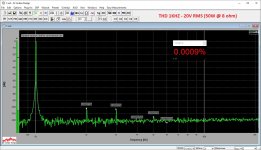 11-@Tube-THD-01k-20v.JPG288.4 KB · Views: 397
11-@Tube-THD-01k-20v.JPG288.4 KB · Views: 397 -
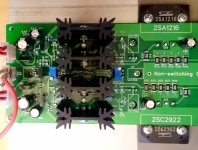 DSC_0117.JPG362.2 KB · Views: 177
DSC_0117.JPG362.2 KB · Views: 177 -
 DSC_0115.JPG484.7 KB · Views: 105
DSC_0115.JPG484.7 KB · Views: 105 -
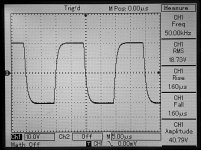 DSC_0113.JPG468 KB · Views: 99
DSC_0113.JPG468 KB · Views: 99 -
 DSC_0111.JPG427.8 KB · Views: 100
DSC_0111.JPG427.8 KB · Views: 100 -
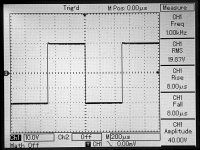 DSC_0110.JPG495.4 KB · Views: 172
DSC_0110.JPG495.4 KB · Views: 172 -
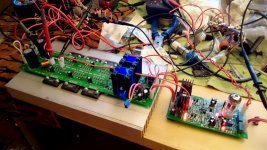 DSC_0109.JPG449.4 KB · Views: 369
DSC_0109.JPG449.4 KB · Views: 369 -
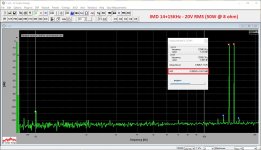 12-@Tube-IMD-14-15k-20v.JPG289.3 KB · Views: 430
12-@Tube-IMD-14-15k-20v.JPG289.3 KB · Views: 430 -
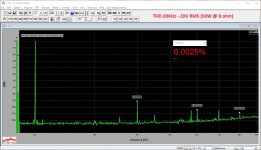 11-@Tube-THD-20k-20v.JPG269.6 KB · Views: 386
11-@Tube-THD-20k-20v.JPG269.6 KB · Views: 386 -
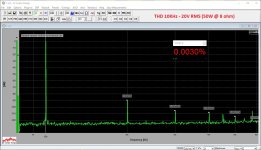 11-@Tube-THD-10k-20v.JPG268.3 KB · Views: 382
11-@Tube-THD-10k-20v.JPG268.3 KB · Views: 382
December 2016. My measurements of the early prototype - the same schematic, but the layout is a TH version of Tubsumo IPS board + NS-OPS early layout. +/-52V rails.
Some differences with the pictures above are most likely caused by the different measurement system setup - I used Lynx L22 card at that time as a hardware.
IMD spectrum is especially nice - 2-nd order component [f2-f1] dominates (green dot on the left), 3-rd order components [f1-(f2-f1)] and [f2+(f2-f1)] are negligible (blue dots on the right).
Clipping at 20KHz is very similar to the one Thimios showed.
Valery,your soundcard is a Top choice and amplifier really is a very low distortion circuit.
My measurements are just what i can measure using an Esi Julia PCI.
What I like - the results are rather consistent, regardless of the different tube manufacturers and layout variations - SMD board is sort of 50% of the TH board size.
Hi Valery,
I feel encouraged in my conviction that if someone claims to hear tonal differences between tubes from different manufacturers, this can be deduced from either expectation bias, or tubes, or a bad amplifier design - or from all of them.
OTOH, a good amplifier design has to be able to level tube wear to some degree, without showing degradation in sound.
This is why I don't like non-NFB designs at all.
Thank you and best regards!
I feel encouraged in my conviction that if someone claims to hear tonal differences between tubes from different manufacturers, this can be deduced from either expectation bias, or tubes, or a bad amplifier design - or from all of them.
OTOH, a good amplifier design has to be able to level tube wear to some degree, without showing degradation in sound.
This is why I don't like non-NFB designs at all.
Thank you and best regards!
TubSumo as built
In case that this will be useful for debugging.
In case that this will be useful for debugging.
Attachments
Last edited:
What do these FET'S in parallel with the triodes do? Do they effectively short them out? Perhaps this TubSuMo would even work without the 12AU7?
Best regards!
Best regards!
What do these FET'S in parallel with the triodes do? Do they effectively short them out? Perhaps this TubSuMo would even work without the 12AU7?
Best regards!
These boards are designed to be tube, fet or bjt input. You just install what you prefer to run.
What do these FET'S in parallel with the triodes do? Do they effectively short them out? Perhaps this TubSuMo would even work without the 12AU7?
Best regards!
They are either / or. We've got the placeholders for those jFETs on the board for those builders who'd like to use them instead of using the triodes - that's why we also have them in the schematic.
Although, my preference - the triodes (I have tested the jFET and BJT options as well).
I was slower than Jeff, heh-heh 😛
P.S. For using jFETs, degeneration resistors' value needs to be increased, for bjt option - to be increased even more.
Last edited:
What you want to see as tested after this?😎
Hi Thimios! Can you please remind us what options are available? 🙂
Hi Thimios! Can you please remind us what options are available? 🙂
IPS
Steadfast
Doppeischleife
Sauberkeit
Complete amplifier.
Simpelstark.
These boards are designed to be tube, fet or bjt input. You just install what you prefer to run.
They are either / or. We've got the placeholders for those jFETs on the board for those builders who'd like to use them instead of using the triodes - that's why we also have them in the schematic.
Ok, thanks, now I see. you had to provide them in your schematics, so that the PCB router acts correctly.
Best regards!
No suggestions?
Thimios, sorry - I started thinking about it a few days ago and then forgot to answer 😛
From my perspective - Sauberkeit would be interesting to test, the second priority would be Steadfast.
I'm going to test Doppelschleife - we had an offset issue in the early prototype, I came up with the solution, so it would be easier for me to see if it works as expected 😉
Cheers,
Valery
- Home
- Amplifiers
- Solid State
- Revisiting some "old" ideas from 1970's - IPS, OPS
